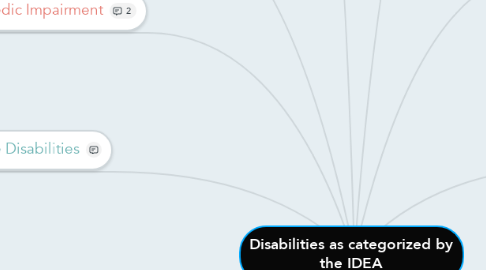Disabilities as categorized by the IDEA
by Pari Valad


1. Emotional Disturbance
1.1. has an inability to learn that cannot be explained by intellectual, sensory, or health factors
1.2. has an inability to build or maintain satisfactory interpersonal relationships with peers and teachers
1.3. has inappropriate types of behavior or feelings under normal circumstances
1.4. has a general pervasive mood of unhappiness or depression.
1.5. has a tendency to develop physical symptoms or fears associated with personal or school problems
2. Hearing Impairment
2.1. may have a speech delay
2.2. may have a peculiar voice or change in pronounciation
2.3. has difficulty articulating
2.4. teacher modification could be the use of videos as an instructional tool using closed caption
3. Intellectual Disability
3.1. has low achievement in most or all academic areas
3.2. has a short attention span and is easily distractible
3.3. has difficulty with working memory tasks
3.4. may operate at a concrete rather than abstract level of thinking
4. Multiple Disabilities
5. Orthopedic Impairment
5.1. spastic movements
5.2. difficulty writing or using hands for school work.
5.3. teachers with access to technology could use transcribers to help student be able to write/type
6. Health Impairment
6.1. weakness and low energy depending on type of impairment
6.2. ADHD is under the disorders that are considered a health impairment
7. Specific Learning Disability
7.1. may be diagnosed with ADD
7.2. perceptual disabilities
8. Autism
8.1. resistance to environmental change
8.2. engaging in repetitive activities
8.3. stereotyped movements
8.4. resistance to environmental change or change in daily routines
8.5. unusual responses to sensory experiences
9. Deaf-Blindness
9.1. severe communication and other developmental and educational needs
9.2. visual and hearing impairment.
10. Deafness
10.1. is impaired with or without amplification of sound
10.2. difficulty following verbal directions (lip reading)
10.3. use of hearing aids
10.4. teachers could use video as a resource for teaching if closed captioning is in use.
11. Speech or Language Impairment
11.1. improper use of words and their meanings
11.2. asks questions and/or responds to questions inappropriately
11.3. has difficulties with figurative language (such as alliteration, similes, metaphors, personification, and idioms)
11.4. cannot give clear directions
12. Traumatic Brain Injury
12.1. impairments
12.1.1. cognition; language; memory; attention;
12.1.2. reasoning; abstract thinking; judgment; problemsolving;
12.1.3. sensory, perceptual, and motor abilities;
12.1.4. psychosocial behavior; physical functions;
12.1.5. information processing; and speech
13. Visual Impairment including Blindness
13.1. physical signs of blindess
13.1.1. crossed eyes
13.1.2. eyes that turn out
13.1.3. eyes that flutter from side to side or up and down
13.1.4. eyes that don't seem to focus
